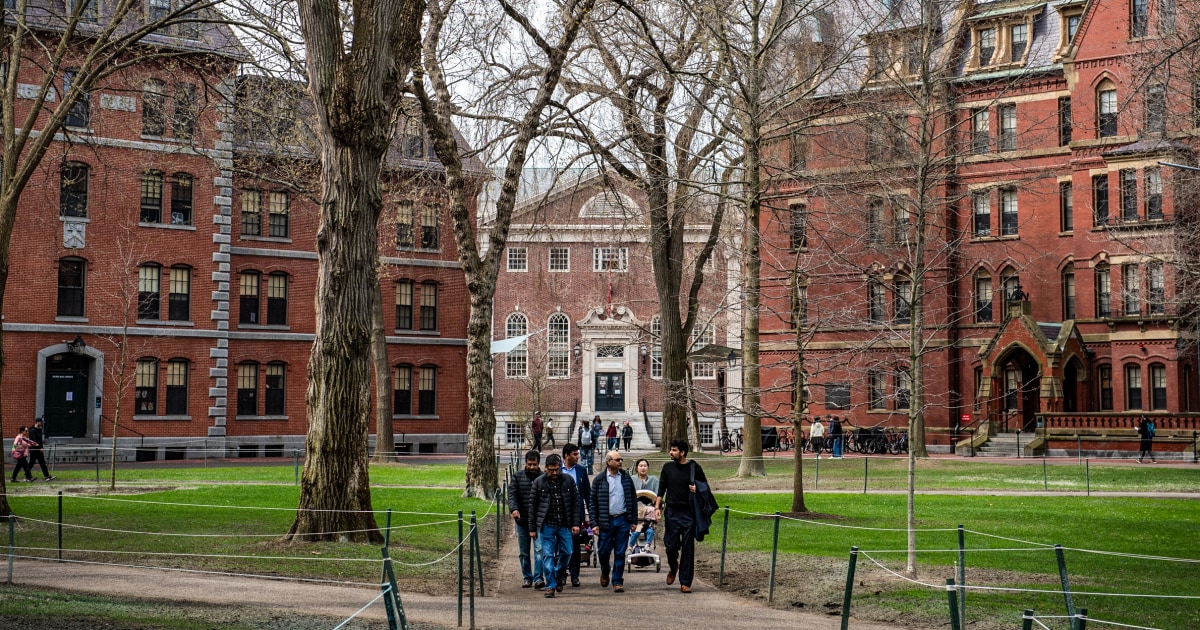Education
What to expect after Trump’s Department of Education executive order

President Donald Trump signed an executive order Thursday in an effort to “begin eliminating the federal Department of Education.” With the stroke of his pen, he officially set in motion a plan to shutter the 46-year-old agency, as he said, “once and for all.”
But the order stops short of immediately closing the department, which cannot be done without congressional approval. Rather, according to the text of the order released by the White House, it directs Education Secretary Linda McMahon to “take all necessary steps to facilitate the closure of the Department of Education and return authority over education to the States and local communities while ensuring the effective and uninterrupted delivery of services, programs, and benefits on which Americans rely.”
Follow live politics coverage here.
At the signing, Trump said federal Pell Grants (a common type of federal undergraduate financial aid), Title I funding and resources and funding for children with disabilities would be “preserved in full and redistributed to various other agencies and departments.”
“But beyond these core necessities, my administration will take all lawful steps to shut down the department,” he said, adding that he’d do so “as quickly as possible.”
The move still promises to upend the key functions the department performs in the broader education system, which include oversight of the federal student loan portfolio, civil rights enforcement in schools and the distribution of billions of dollars to help impoverished and disabled students.
Several big questions about the Department of Education’s future remain unanswered. But there is still a significant amount known about the agency’s history and duties — as well as the many plans conservatives have circulated for decades to unwind the agency.
What does the Department of Education do?
In 1979, Democratic President Jimmy Carter signed legislation that made the Department of Education a Cabinet-level agency. Until that point, the government had a Department of Health, Education and Welfare, created during the Eisenhower administration.
Conservatives have been clamoring to abolish it for more than 40 years — essentially since it was created. Carter’s successor, President Ronald Reagan, vowed to shut it down one year after it opened — and Republicans have basically repeated that call since.
The Education Department is one of the smallest Cabinet-level departments. Its $268 billion appropriation last year represented 4% of the U.S. budget. McMahon announced earlier this month a plan to cut roughly half of the agency’s staff.
Among its most prominent duties, the agency manages the $1.6 trillion federal student loan portfolio for college and postsecondary students. It also distributes billions of dollars in funding for K-12 schools through programs that serve more than 50 million students in nearly 100,000 public schools and 32,000 private schools.
That funding includes more than $15 billion for thousands of so-called Title I schools — schools that receive federal dollars to help low-income families. And it includes more than $15 billion in funding for programs — under the auspices of the Individuals with Disabilities Education Act (IDEA), which provides grants to states for the education of children with disabilities — that ensure disabled students have access to a free and appropriate public education.
The Department of Education’s Office for Civil Rights enforces laws aiming to prevent discrimination in schools, and the agency’s Institute of Education Sciences runs data collection, statistics and research monitoring student outcomes.
The vast balance of power on education, however, still lies with states and local districts, which fund the bulk of K-12 education and set all curriculums.
The U.S. Department of Education has no say in curriculum matters. It does not set requirements for enrollment and graduation in schools, nor does it have a say in the selection or use of school or library books, textbooks or resources.
Schools that receive federal money through Title I programs and IDEA must meet specific conditions and maintain specific reporting rules. Conservatives have long claimed that those requirements are arduous and have pushed for allowing states to have flexibility and freedom to spend the money as they wish.
What would it look like to wind down the Education Department?
Even though Trump cannot fully end the Department of Education himself, McMahon agreed at her confirmation hearing that the administration hopes to present a plan that Congress would support, and Republicans in the House have introduced various plans that seek to eliminate the department. Still, with narrow Republican majorities in the House and Senate, it’s unlikely to move forward.
Yet short of that, the administration has other ways to shrink the department’s footprint.
White House press secretary Karoline Leavitt said ahead of the executive order’s signing that “critical programs will be protected” and that, specifically, student loans and federal Pell Grants would continue to be handled by the department. In addition, a senior administration official said Wednesday night that Title I, student loans and students with disabilities — who rely on IDEA funding — will not be affected.
But it remains unclear how existing services would not be interrupted as the agency is dismantled.
Education advocates have long warned that major cutbacks would dramatically affect the federal government’s enormous student loan portfolio and Title I and IDEA funding. What these cuts would mean for groups who rely on that funding remains one of the biggest questions to emerge after news first broke that the Trump White House was looking to eliminate the agency.
One possibility is that the new framework for education policy could take its cues from the many plans that conservative education activists have circulated for decades on how they’d like to see the department disemboweled. Those plans largely center on transferring key functions of the department to other federal agencies, even though some education experts contend that even those transfers would require congressional approval.
One House bill introduced in January by Rep. David Rouzer, R-N.C., proposes transferring most of the department’s responsibilities to other agencies. Student loan programs would go to the Treasury Department, for example, and job training programs to the Labor Department.
The bill also proposes that the federal government be allowed to provide nearly all other education funding it currently gives to states with almost no conditions or reporting requirements attached.
One plan from February touted by officials at the conservative Manhattan Institute for Policy Research pushed for transferring civil rights enforcement issues in public schools to the Civil Rights Division of the U.S. Department of Justice.
Education advocates have warned that moving those responsibilities to the DOJ would likely result in fewer investigations and less enforcement, because it would mean saddling a smaller team with even more responsibilities. The Justice Department also has discretion in which cases it investigates, whereas the Education Department is required to investigate complaints alleging discrimination within the past 180 days. (The Trump administration’s layoffs at the Education Department earlier this month greatly impacted the agency’s Office for Civil Rights.)
That plan also advocated for spinning off the federal student loan portfolio into an independent financial entity.
Meanwhile, Project 2025 — which pushed for abolishing the whole agency — also advocated for ending Title I funding in phases. It also proposes ending student debt cancellation programs.
Other advocates for conservative education policy have said the federal government should convert most of the funding it gives to states for K-12 programs into block grants, a form of funding that comes with fewer rules and less federal oversight.
But public education advocates have warned that kind of shift could allow red states to pour dollars into private schools, which do not have to abide by federal education civil rights laws.
Under some other GOP proposals, Title I funding for the poorest schools would shift to allow poor students to take that money to private schools if they choose.
In February, a dozen top education officials from GOP-controlled states pitched McMahon on giving out federal school funding as block grants. Those Republicans said they wanted to be allowed to shift funding to support “state-driven initiatives” and “alternative spending approaches,” and asked McMahon to grant them waivers on certain federal requirements that come with their allocations. Red states typically rely more heavily on federal education funding than blue ones.
Private schools that do not receive federal funding are exempt from civil rights laws, such as those barring discrimination based on a student’s race, gender or disability. Private academies also do not have to provide individualized education plans to children with learning disabilities. It’s unclear whether any of the federal civil rights protections overseen by the Department of Education would apply if states used federal dollars to support private K-12 schools under their proposed block grant schemes.
Education
Judge orders detained Tufts student Rumeysa Öztürk to be transferred back to Vermont

A federal judge on Friday ordered that the Tufts University student who wrote an essay about Israel and the war in Gaza and is now fighting deportation must be transferred back to Vermont.
Judge William K. Sessions III stayed his order for four days to give the government a chance to appeal.
Rumeysa Öztürk, a 30-year-old Turkish national in the United States on a visa, is being held at an Immigration and Customs Enforcement detention center in Louisiana.
In Friday’s ruling, the judge refused efforts by the government to dismiss her habeas petition.
He found that Öztürk “has raised significant constitutional concerns with her arrest and detention.”
The Tufts doctoral student was arrested March 25 in Somerville, Massachusetts, and the Department of Homeland Security has accused her of engaging “in activities in support of Hamas.”
She co-wrote an opinion essay in 2024 for the student newspaper that called on Tufts to “acknowledge the Palestinian genocide,” which the undergraduate student government had demanded in a resolution.
The essay criticized university leadership for its response to the student government’s resolutions that it “disclose its investments and divest from companies with direct or indirect ties to Israel.”
“A university op-ed advocating for human rights and freedom for the Palestinian people should not lead to imprisonment,” one of her attorneys, Mahsa Khanbabai, said Friday. “Our immigration laws should not be manipulated to rip people away from their homes and their loved ones.”
Öztürk’s attorneys called Friday’s ruling a victory, and said that the federal government was trying to manipulate where her case would be heard so that it could try for its preferred outcome.
Friday’s ruling allows Öztürk to remain in ICE custody in Vermont while her habeas petition, which challenges her detainment, proceeds in federal court, as well as her removal case in immigration court in Louisiana.
The Department of Justice declined to comment Friday.
Öztürk is one of a number of international students in the U.S. on visas who the Trump administration is trying to deport for their actions protesting the conduct of Israel in its war against Hamas in Gaza, which it launched after the Hamas attacks on Israel on Oct. 7, 2023.
Tufts University has defended Öztürk and has petitioned that she be released from custody. The university said the opinion essay did not violate its policies and was in accordance with its position on free speech.
“The University has no further information suggesting that she has acted in a manner that would constitute a violation of the University’s understanding of the Immigration and Naturalization Act,” the university leadership said in a declaration earlier this month.
Education
Harvard’s battle with the Trump administration is creating a thorny financial situation

Harvard’s brewing conflict with the Trump administration could come at a steep cost — even for the nation’s richest university.
On April 14, Harvard University President Alan Garber announced the institution would not comply with the administration’s demands, including to “audit” Harvard’s students and faculty for “viewpoint diversity.” The federal government, in response, froze $2.2 billion in multi-year grants and $60 million in multi-year contracts with the university.
According to CNN and multiple other news outlets, the Trump administration has now asked the Internal Revenue Service to revoke Harvard’s tax-exempt status. If the IRS follows through, it would have severe consequences for the university. The many benefits of nonprofit status include tax-free income on investments and tax deductions for donors, education historian Bruce Kimball told CNBC.
Bloomberg estimated the value of Harvard’s tax benefits in excess of $465 million in 2023.
Nonprofits can lose their tax exemptions if the IRS determines they are engaging in political campaign activity or earning too much income from unrelated activities. Few universities have lost their non-profit status. One of the few examples was Christian institution Bob Jones University, which lost its tax exemption in 1983 for racially discriminatory policies.
White House spokesperson Harrison Fields told the Washington Post that the IRS started investigating Harvard before President Donald Trump suggested on Truth Social that the university should be taxed as a “political entity.” The Treasury Department did not reply to a request for comment from CNBC.
A Harvard spokesperson told CNBC that the government has “no legal basis to rescind Harvard’s tax exempt status.”
“The government has long exempted universities from taxes in order to support their educational mission,” the spokesperson wrote in a statement. “Such an unprecedented action would endanger our ability to carry out our educational mission. It would result in diminished financial aid for students, abandonment of critical medical research programs, and lost opportunities for innovation. The unlawful use of this instrument more broadly would have grave consequences for the future of higher education in America.”
The federal government has challenged Harvard on yet another front, with the Department of Homeland Security threatening to stop international students from enrolling. The Student and Exchange Visitor Program is administered by Immigration and Customs Enforcement, which falls under the DHS.
International students make up more than a quarter of Harvard’s student body. However, Harvard is less financially dependent on international students than many other U.S. universities as it already offers need-based financial aid to international students in its undergraduate program. Many other universities require international students to pay full tuition.
The Harvard spokesperson declined to comment to CNBC on whether the university would sue the administration over the federal funds or any other grounds. Lawyers Robert Hur of King & Spalding and William Burck of Quinn Emanuel are representing Harvard, stating in a letter to the federal government that its demands violate the First Amendment.
Harvard, the nation’s richest university, has more resources than other academic institutions to fund a long legal battle and weather the storm. However, its massive endowment — which has raised questions during the recent developments — is not a piggy bank.
Why Harvard’s endowment is so large
Harvard has an endowment of nearly $52 billion, averaging $2.1 million in endowed funds per student, according to a study by the National Association of College and University Business Officers, or NACUBO, and asset manager Commonfund.
That size makes it larger than than the GDP of many countries.
The endowment generated a 9.6% return last fiscal year, which ended June 30, according to the university’s latest annual report.
Founded in 1636, Harvard has had more time to accumulate assets as the nation’s oldest university. It also has robust donor base, receiving $368 million in gifts to the endowment in 2024. While the university noted that more than three-quarters of the gifts averaged $150 per donor, Harvard has a history of headline-making donations from ultra-rich alumni.
Kimball, emeritus professor of philosophy and history of education at the Ohio State University, attributes the outsized wealth of elite universities like Harvard to a willingness to invest in riskier assets.
University endowments were traditionally invested very conservatively, but in the early 1950s Harvard shifted its allocation to 60% equities and 40% bonds, taking on more risk and creating the opportunity for more upside.
“Universities that didn’t want to assume the risk fell behind,” Kimball told CNBC in March.
Other universities soon followed suit, with Yale University in the 1990s pioneering what would become the “Yale Model” of investing in alternative assets like hedge funds and natural resources. Though it proved lucrative, only universities with large endowments could afford to take on the risk and due diligence that was needed to succeed in alternative investments, according to Kimball.
According to Harvard’s annual report, the largest chunks of the endowment are allocated to private equity (39%) and hedge funds (32%). Public equities constitute another 14% while real estate and bonds/TIPs make up 5% each. The remainder is divided between cash and other real assets, including natural resources.
The university has made substantial portfolio allocation changes over the past seven years, the report notes. The Harvard Management Company has cut the endowment’s exposure to real estate and natural resources from 25% in 2018 to 6%. These cuts allowed the university to increase its private equity allocation. To limit equity exposure, the endowment has upped its hedge fund investments.
The endowment is not a piggy bank
University endowments, though occasionally staggering in size, are not slush funds. The pools are actually made up of hundreds or even thousands of smaller funds, the majority of which are restricted by donors to be dedicated to areas including professorships, scholarships or research.
Harvard has some 14,600 separate funds, 80% of which are restricted to specific purposes including financial aid and professorships. Last fiscal year, the endowment distributed $2.4 billion, 70% of which was subject to donors’ directives.
“Most of that money was put in for a specific purpose,” Scott Bok, former chairman of the University of Pennsylvania, told CNBC in March. “Universities don’t have the ability to break open the proverbial piggy bank and just grab the money in whatever way they want.”
Some of these restrictions are overplayed, according to former Northwestern University President Morton Schapiro.
“It’s true that a lot of money is restricted, but it’s restricted to things you’re going to spend on already like need-based aid, study abroad, libraries,” Bok said previously.
How Harvard is shoring up its finances
Harvard has $9.6 billion in endowed funds that are not subject to donor restrictions. The annual report notes that “while the University has no intention of doing so,” these assets “could be liquidated in the event of an unexpected disruption” under certain conditions.
Liquidating $9.6 billion in assets, nearly 20% of total endowed funds, would come at the cost of future cash flow, as the university would have less to invest.
Harvard did not respond to CNBC’s queries about increasing endowment spending. Like most universities, it aims to spend around 5% of its endowment every year. Assuming the fund generates high-single-digit investment returns, spending just 5% allows the principal to grow and keep pace with inflation.
For now, Harvard is taking a hard look at its operating budget. In mid-March, the university started taking austerity measures, including a temporary hiring pause and denying admission to graduate students waitlisted for this upcoming fall.
Harvard is also issuing $750 million in taxable bonds due September 2035. This past February, the university issued $244 million in tax-exempt bonds. A slew of universities including Princeton and Colgate are also raising debt this spring.
So far, Moody’s has not updated its top-tier AAA rating for Harvard’s bonds. However, when it comes to higher education as a whole, the ratings agency isn’t so optimistic, lowering its outlook to negative in March.
Education
Trump admin threatens to stop Harvard from enrolling foreign students

The Trump administration is continuing its battle against Harvard University — this time, canceling $2.7 million in grants and threatening to stop the enrollment of international students.
Homeland Security Secretary Kristi Noem on Wednesday announced the cancellation of two DHS grants to the school, declaring it “unfit to be entrusted with taxpayer dollars.”
Noem also said she sent a letter to Harvard demanding “detailed records” on foreign student visa holders’ “illegal and violent activities” by April 30.
If Harvard does not meet that deadline, it’ll immediately lose its Student and Exchange Visitor Program certification, she warned.
The release alleged Harvard’s foreign visa holders participated in riots and spewed antisemitic hate targeting Jewish students following the Hamas incursion against Israel on Oct. 7, 2023.
“If Harvard cannot verify it is in full compliance with its reporting requirements, the university will lose the privilege of enrolling foreign students,” a DHS news release said.
The two canceled grants were: an $800,303 grant for Implementation Science for Targeted Violence Prevention, which Noem said “branded conservatives as far-right dissidents in a shockingly skewed study,” and a $1.9 million Blue Campaign Program Evaluation and Violence Advisement grant that Noem alleged “funded Harvard’s public health propaganda.”
“Harvard bending the knee to antisemitism — driven by its spineless leadership — fuels a cesspool of extremist riots and threatens our national security,” Noem said in a statement. “With anti-American, pro-Hamas ideology poisoning its campus and classrooms, Harvard’s position as a top institution of higher learning is a distant memory. America demands more from universities entrusted with taxpayer dollars.”
It’s the latest punch by the Trump administration against the nation’s most prestigious university.
Earlier this week, the Trump administration announced that it would freeze more than $2 billion in grants to Harvard after the institution refused to accept demands that included auditing the viewpoints of its student body. Trump has also called for Harvard to lose its tax-exempt status.
On Monday, Harvard University’s lawyers sent a letter rejecting a list of demands from the Trump administration. In a statement posted online, Harvard President Alan Garber referred to the demands as “an attempt to control the Harvard community” and vowed to fight back.
A Harvard spokesperson told NBC News on Thursday that the school will “not surrender its independence or relinquish its constitutional rights,” while complying with the law.
-

 Conflict Zones24 hours ago
Conflict Zones24 hours agoTrump says US may ‘pass’ on helping end war if Russia, Ukraine resist deal | Russia-Ukraine war News
-

 Education1 day ago
Education1 day agoHarvard’s battle with the Trump administration is creating a thorny financial situation
-

 Lifestyle1 day ago
Lifestyle1 day agoSweets from the sky! A helicopter marshmallow drop thrills kids in suburban Detroit
-

 Sports1 day ago
Sports1 day agoAaron Rodgers ‘not holding anybody hostage’ as he decides his future, retirement a possibility
-

 Europe1 day ago
Europe1 day agoLive updates: Trump news, Ukraine peace talks, US immigration, tariffs and university funding
-

 Sports2 days ago
Sports2 days agoNY Rangers’ Panarin, MSG reportedly made settlement payments after employee made sexual assault allegations
-

 Education2 days ago
Education2 days agoTrump admin threatens to stop Harvard from enrolling foreign students
-

 Middle East21 hours ago
Middle East21 hours agoDeadly, sombre Good Friday as 58 people killed in Israeli attacks on Gaza | Israel-Palestine conflict News




